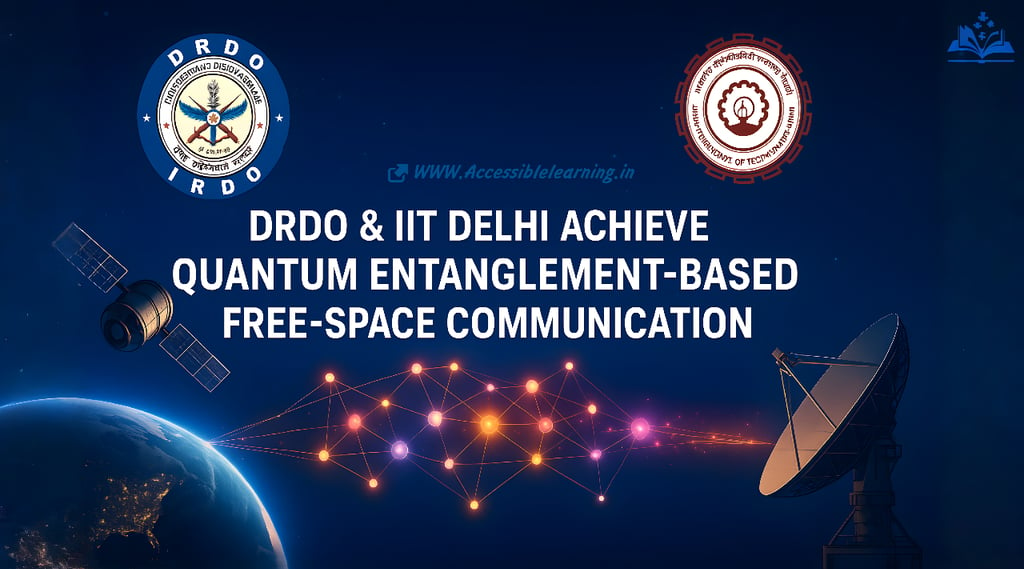
DRDO & IIT Delhi Achieve Breakthrough in Quantum Entanglement-Based Free-Space Communication
India enters the global quantum race! DRDO and IIT Delhi achieve a major breakthrough in quantum entanglement-based free-space communication, marking a bold step toward unhackable networks, satellite quantum links, and defense-grade encryption. Discover how this game-changing innovation could shape India’s cybersecurity and quantum future.
NEWS/CURRENT AFFAIRSSPACE/TECHNEPOTISM/SOCIAL ISSUES
Keshav Jha
6/19/20253 min read


In a monumental stride toward securing India’s future in quantum technologies, the Defence Research and Development Organisation (DRDO), in collaboration with the Indian Institute of Technology (IIT) Delhi, has successfully demonstrated quantum entanglement-based free-space communication. This experimental success not only establishes India's quantum readiness but also positions the country among the few global powers advancing toward quantum-secure networks and unhackable communication systems.
This landmark demonstration is a precursor to quantum satellite communication, inter-city QKD (Quantum Key Distribution), and eventually, the quantum internet—an innovation that promises impenetrable cybersecurity for both defense and civilian sectors.
What Is Quantum Entanglement-Based Communication?
Quantum entanglement refers to a mysterious but real phenomenon where two particles, such as photons, become so deeply linked that measuring one instantly determines the state of the other—even if separated by large distances. This bizarre connectivity is the basis of QKD (Quantum Key Distribution).
In QKD, encryption keys are shared through entangled particles. Any attempt to eavesdrop would disturb the quantum state, making such interception not only detectable but also rendering the communication unusable to the attacker. Unlike classical encryption methods that can be cracked using brute-force or AI algorithms, quantum entanglement ensures theoretical immunity to hacking.
What Exactly Was Achieved by DRDO and IIT Delhi?
The collaborative effort led to a successful transmission of entangled photons across a free-space path, thereby validating India’s ability to develop quantum-safe optical communication systems. Here’s a breakdown of the major technical achievements:
Core Accomplishments
Generation of high-fidelity entangled photon pairs using Spontaneous Parametric Down-Conversion (SPDC).
Free-space transmission of quantum states over an open-air channel up to 300 meters.
Successful synchronization and decoding of quantum keys with minimal Quantum Bit Error Rate (QBER).
Real-time tracking and alignment using an advanced beam steering and stabilization system.
Preservation of entanglement using time-bin encoding, which is more robust against environmental noise compared to polarization-based encoding.
This is particularly noteworthy because free-space communication is far more challenging than fiber-based QKD due to issues like turbulence, beam wandering, and photon loss caused by atmospheric particles.
Why Is Free-Space Quantum Communication Crucial?
Free-space quantum communication plays a strategic and scalable role in the development of quantum technologies:
Satellite-Based Quantum Networks
India aims to join the league of nations like China and the U.S., which have already demonstrated quantum satellite links (e.g., China’s Micius satellite). Free-space tests are critical for ground-to-satellite entangled communication, paving the way for Quantum Satellite Missions under India’s space and defense initiatives.
Military & Mobile Security
While fiber-based QKD is geographically limited and infrastructure-dependent, free-space systems can be rapidly deployed in mobile units, war zones, and high-altitude areas. These systems allow secure communication between naval vessels, UAVs, satellites, and mobile command centers.
Quantum Urban Networks
As Indian cities grow into digital megastructures, air-based QKD can complement fiber-based infrastructure. Think of secure communication between government buildings, stock exchanges, and smart city grids—made possible without needing new underground cables.
Technological Details Behind the Breakthrough
The setup included
Laser source: Pumping into a nonlinear crystal for SPDC.
Entanglement type: Time-bin entanglement, better suited for long-distance and free-space.
Photon detectors: Ultra-sensitive, low-noise single-photon detectors.
Tracking system: Real-time correction with active beam stabilization and feedback control using GPS and inertial systems.
Software stack: Quantum cryptographic protocols layered with AI-optimized signal processing and data correction algorithms.
Despite high levels of environmental interference—like heat, air particles, and building reflection—the entangled photon pairs retained coherence, proving the system's ruggedness and reliability.
Strategic Implications for India
This project is not a standalone feat; it directly aligns with India’s larger vision under the National Quantum Mission (NQM), which earmarks ₹6,000 crores for quantum tech R&D by 2031. India now confidently enters the global arena where countries are racing to dominate quantum supremacy in communication.


Next Steps & Future Developments
The road ahead for DRDO and IIT Delhi includes
Scaling the entanglement range to 5–10 km in urban or semi-urban testbeds.
Initiating India’s first quantum satellite prototype, likely under ISRO’s coordination.
Integrating quantum repeaters and memory units to build larger quantum networks.
Forming academic-industry consortia to encourage startups and research labs to participate in national quantum development.
Building quantum-secure infrastructure for defense ministry, RBI, SEBI, and other critical institutions.
DRDO is also expected to collaborate with private telecom firms and quantum computing startups for applied research and secure hardware development.
The DRDO-IIT Delhi collaboration marks a defining moment in India’s scientific and strategic evolution. Free-space quantum communication is no longer theoretical—it's a working technology now within India’s grasp.
As cyberwarfare intensifies and global geopolitics lean heavily on tech superiority, India’s success in entanglement-based communication shields its future with quantum armor. It’s not just a signal beam that was sent—it’s a signal that India is ready to lead in the age of quantum sovereignty.
Subscribe to our newsletter
All © Copyright reserved by Accessible-Learning
| Terms & Conditions
Knowledge is power. Learn with Us. 📚


